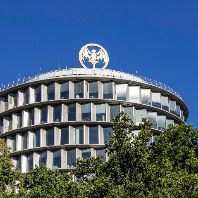While austerity measures and concerns surrounding sovereign debt in European economies triggered a new wave of economic uncertainty and volatility in financial markets; positive signs increased in the office markets during Q2 2010 according to Jones Lang LaSalle's Q2 2010 European Property Clock.
Office take-up in Europe for Q2 2010 increased marginally to 2.6 million m², up 6% on the previous quarter and 34% on Q2 2009. Take up for H1 2010 is now 38% higher than for the same period in 2009, having improved in both Western Europe and CEE up by 32% and 73% respectively over the same period.
Prime rental levels stabilized in the majority of locations in Q2 and the Office Index, based on the weighted performance of 24 markets, increased by 2.6% q-o-q, building upon the growth seen during Q1 and showing the first positive growth (+2.1%) on an annual level since Q3 2008. The biggest rise in rents was seen in London's West End (13.3%), Paris (7.1%), City of London (5.3%) and Dusseldorf (2.3%). Quarterly rental falls were however recorded in Dublin (-5.3%), Frankfurt (-2.9%), Madrid (-2.6%), Barcelona (-2.4%) and Hamburg (-2.2%). Incentives offered by landlords also stabilized with some markets seeing incentives reducing such as London City, London West End, Bucharest and Hamburg.
Chris Staveley, head of Pan-European Office and Industrial Capital Markets at Jones Lang LaSalle, said: "Signs of economic recovery are beginning to feed through into office demand, but occupiers still remain cautious and we expect annual volumes to be slightly below the five-year average of 11 million m²."
Approximately 1.4 million m² of new stock was added in Q2, a 25% increase on the first quarter. Despite this new stock, tightening supply of quality space is driving rental stability and even growth, but there are significant differences in current total supply levels and sentiment - across the region which has led to differences in outlook.
The average European vacancy rate remained stable in Q2 at 10.2%, despite these additions, the same level as in Q1 10 and Q4 09. The vacancy rate increased slightly to 9.8% in Western Europe but fell substantially in CEE from 16.4% to 14.6%. This decline was particularly driven by decreases in Moscow and Budapest, whilst increases where recorded in both Prague and Warsaw.
Chris Staveley added: "Though half of the markets analysed saw vacancy rates increasing, the overall pace is easing and we believe most markets have reached or passed their peak. High vacancy rates, of over 15%, can still however be found in Amsterdam, Dublin, Budapest and Moscow and there remains a significant spread across Europe with Paris now showing the lowest vacancy rate at 6.8%.
"Given the large number of projects that were postponed during the credit crunch, a shortage of new supply is anticipated as early as 2011 in some markets. Conversely, the supply of second hand space is likely to increase further in some markets during 2010 as occupiers seek to rationalise or even upgrade their space. As a consequence Grade A supply is likely to continue to decline but the overall vacancy rate will r
Prime rental levels stabilized in the majority of locations in Q2 and the Office Index, based on the weighted performance of 24 markets, increased by 2.6% q-o-q, building upon the growth seen during Q1 and showing the first positive growth (+2.1%) on an annual level since Q3 2008. The biggest rise in rents was seen in London's West End (13.3%), Paris (7.1%), City of London (5.3%) and Dusseldorf (2.3%). Quarterly rental falls were however recorded in Dublin (-5.3%), Frankfurt (-2.9%), Madrid (-2.6%), Barcelona (-2.4%) and Hamburg (-2.2%). Incentives offered by landlords also stabilized with some markets seeing incentives reducing such as London City, London West End, Bucharest and Hamburg.
Chris Staveley, head of Pan-European Office and Industrial Capital Markets at Jones Lang LaSalle, said: "Signs of economic recovery are beginning to feed through into office demand, but occupiers still remain cautious and we expect annual volumes to be slightly below the five-year average of 11 million m²."
Approximately 1.4 million m² of new stock was added in Q2, a 25% increase on the first quarter. Despite this new stock, tightening supply of quality space is driving rental stability and even growth, but there are significant differences in current total supply levels and sentiment - across the region which has led to differences in outlook.
The average European vacancy rate remained stable in Q2 at 10.2%, despite these additions, the same level as in Q1 10 and Q4 09. The vacancy rate increased slightly to 9.8% in Western Europe but fell substantially in CEE from 16.4% to 14.6%. This decline was particularly driven by decreases in Moscow and Budapest, whilst increases where recorded in both Prague and Warsaw.
Chris Staveley added: "Though half of the markets analysed saw vacancy rates increasing, the overall pace is easing and we believe most markets have reached or passed their peak. High vacancy rates, of over 15%, can still however be found in Amsterdam, Dublin, Budapest and Moscow and there remains a significant spread across Europe with Paris now showing the lowest vacancy rate at 6.8%.
"Given the large number of projects that were postponed during the credit crunch, a shortage of new supply is anticipated as early as 2011 in some markets. Conversely, the supply of second hand space is likely to increase further in some markets during 2010 as occupiers seek to rationalise or even upgrade their space. As a consequence Grade A supply is likely to continue to decline but the overall vacancy rate will r
















